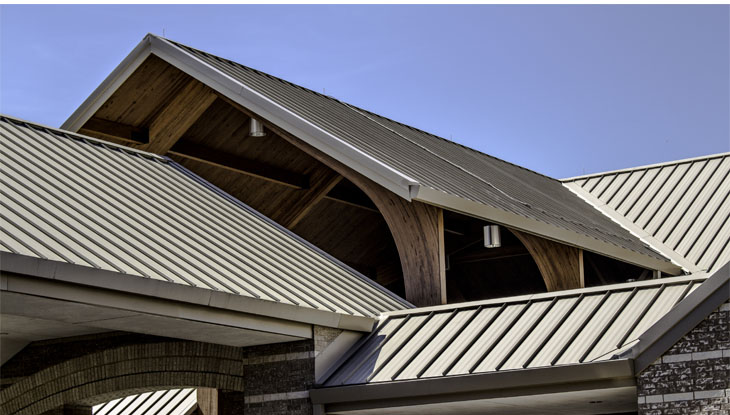
ROOF MAINTENANCE AND INSPECTIONS
Posted on June 8, 2023 by Heritage

Roof Inspections and Maintenance
Your metal roof is engineered to offer years of protection with minimal upkeep. Nevertheless, it’s essential to bear in mind that no roof is completely immune to extreme weather conditions or completely maintenance-free. To maintain your roof’s optimal performance, it is recommended to establish a regular maintenance program.
Safety Measures
Walking on any roof can be hazardous. This is why we emphasize the utmost importance of consistently utilizing fall protection and personal safety equipment mandated by OSHA and other regulatory agencies. Failure to comply with these regulations may result in severe injuries or even fatalities. Additionally, noncompliance can lead to significant fines.
When conducting roof maintenance or inspections, always keep in mind the following guidelines:
- All maintenance personnel must undergo adequate training in safety procedures
- Verification is necessary to ensure that safety equipment is in proper working order
- Avoid walking on roof flashings such as gutters, rakes, hips, or ridges
- Refrain from walking on skylights or Light Transmitting Panels (LTPs)
- Exercise extreme caution on steep slopes or near edges, especially when the roof is wet or covered in ice/snow
Annual Roof Check
Inspect the seals and loose fasteners in the joints of roof panels and associated trims. For any necessary repairs, get in touch with the original installation contractor or Heritage for recommendations on qualified contractors in your area.
Gutters and Downspouts
Regularly clear all debris such as leaves and dirt from gutters and downspouts as required. At a minimum, this cleaning should be done twice a year.
Ensure Proper Drainage
Maintaining proper drainage is crucial for the performance of your roof. Follow these guidelines:
- Keep the roof free of debris and obstructions
- Avoid installing anything on the roof that can hold moisture or cause water to accumulate
- Do not use wood to support rooftop equipment or pipes, as it may impede water flow and compromise the roof’s warranty coverage. Instead, utilize a suitable metal roof clamping system like S-5! or similar alternatives
- Ensure that water is channeled appropriately by using gutters and downspouts when necessary
- Avoid letting water from adjacent roofs cascade onto your roof. Implement proper drainage systems
- Do not allow rooftop air conditioning units or evaporative coolers to drain directly onto the roof. Use PVC pipes to carry condensate to the gutters
Roof Inspection
In the event of fire, vandalism, or known damage to an adjacent roof area, perform a thorough inspection of your roof under the following circumstances:
- After exposure to severe weather conditions
- Following high winds, check for debris, loose panels/trims/fasteners/closures, and punctures
- After hailstorms, inspect for damaged trim and loose fasteners
- After heavy rains, check for ponding water at roof laps, roof curbs/penetrations, gutters, and all trims
- After sliding snow/ice, examine perimeter trims, plumbing pipes/roof penetrations, etc., and check for loose fasteners at trim and panel endlaps
Trade Notifications
Before allowing any trades on the roof panels, ensure they adhere to the following guidelines:
- Protect against foot traffic damage, roof scratches, and dents by using appropriate roof covers in work areas.
- Make prior arrangements with roofing contractors to ensure professionally designed and installed penetrations.
- Remove all construction debris, including metal shavings, sealants, wood scraps, and fasteners.
- Use fire cloth to protect the roof wherever welding equipment or cutoff saws are employed.
- Immediately clean up spilled chemicals/solvents on the roof and thoroughly rinse affected areas with water.
Foot Traffic
Effective management of foot traffic is essential to minimize damage to metal roof systems. Tradesmen should consider the following safety precautions when walking or standing on roof panels:
- Install roof walkway systems in areas with regular foot traffic.
- Minimize unnecessary traffic by limiting access to the roof, roof hatches, and access ladders.
- Post signs at access points and ensure that only authorized personnel are allowed on the roof.
- Keep a logbook of all visits to the roof, noting the purpose of each visit.
Ice and Snow Removal
To prevent damage, promptly remove excessive snow and ice from the roof when it is safe to do so. Pay attention to gutter areas (eaves and valleys) as well as areas sheltered from the wind (behind facades, step roof conditions, etc.). Exercise extreme caution during removal and follow all roof safety procedures.
- Avoid using metal tools to remove ice or snow, as they can damage the paint and/or Galvalume coatings.
- Take care not to disturb plumbing pipes and flashings.
- Be mindful of skylights and light transmitting panels (LTPs), as they are not designed to support a person’s weight and can be difficult to locate when covered with ice and snow.
- Remove snow evenly from both sides of a gabled roof to maintain balanced loads.
By implementing the precautions discussed in this article, tradesmen can ensure the safety of their team during routine roof maintenance and inspections while extending the lifespan of their roofs, ultimately saving valuable time and money.
For more information about Heritage’s warranties and ensuring your installations can withstand the toughest storms, please visit our warranties page.